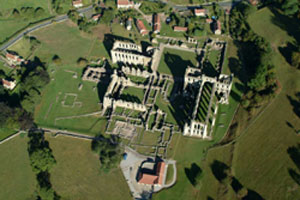 |
 |
 |
 |
 |
 |
 |
|
Rievaulx during William’s abbacy (1132-45) (2/6)
The community was fortunate to have important resources at hand. Freshwater springs provided a ready supply of water for drinking and drainage, as well as a source of power. The site itself was surrounded by woodland, creating ‘a second paradise of wooded delight’. This not only afforded privacy and shelter, but yielded valuable building materials. These natural resources were supplemented by Walter Espec’s foundation grant which permitted the community to take dead wood and timber from Griff and Tillostan. A later gift, c. 1145, granted it the right to gather wood in Walter’s forest of Helmsley, which could be used to construct buildings, fences, bridges, sheepfolds and roofing.
For example, high quality sandstone that was used in the twelfth century was taken from Wethercote quarries on Wethercote Moor, and clay for roof tiles was also obtained from here. There were also several quarries nearby, which meant that the monks had at their disposal various kinds of stone. Durable limestone was quarried at Helmsley and from Griffe Bank quarries, which lay just over a kilometre from the abbey church. This oolite limestone was used in the choir of the church, in the thirteenth-century refectory and for Abbot William’s shrine. The community also imported Purbeck marble which was essentially used for the grave cover in the eastern nave and also for decorative free-standing shafts.(3) |

